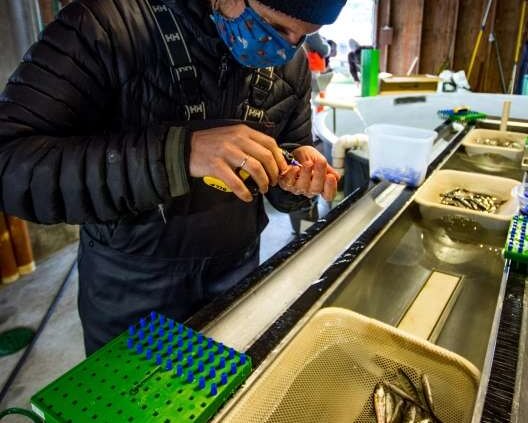Key Findings from 5-year Study on Salish Sea Salmon Declines
(photo credit: Danny Swainson, BC Conservation Foundation. PSF Biologist Collin Middleton inserts a PIT tag into a juvenile Coho at the Nanaimo Hatchery. His work is a continuation of the Salish Sea Marine Survival Project’s studies on tracking when and where salmon die and why.)
FOR IMMEDIATE RELEASE
July 27, 2021
PACIFIC SALMON FOUNDATION PUBLISHES KEY FINDINGS FROM FIVE YEAR STUDY ON SALISH SEA SALMON DECLINES
Pathogens, Predators, and Production Studied to Determine Salmon Recovery
VANCOUVER – The Pacific Salmon Foundation (PSF) published findings from its five-year Salish Sea Marine Survival Project studying chronic Pacific salmon declines in the Salish Sea. The findings have resulted in several restoration initiatives, and a closer evaluation of salmon aquaculture, salmon hatcheries and policies affecting salmon habitat in British Columbia.
“The Salish Sea Marine Survival Project made significant contributions to understanding what determines the abundance of our wild Pacific Salmon,” says Dr. Brian Riddell, PSF Science Advisor, who co-led the program with Dr. Isobel Pearsall, PSF Director of Marine Science. “This project will enable the implementation of key management actions to benefit Chinook and coho production.”
Preliminary findings, include:
- The presence of a dozen pathogens has been associated with poorer body condition and survival for Chinook, Coho, and Sockeye salmon in the southern Strait of Georgia. The study was the first to find Piscine orthoreovirus and associated diseases in BC’s aquaculture salmon, prompting the Foundation to support a phase-out of open-net-pen salmon aquaculture in British Columbia.
- Fifteen viruses were discovered that had not previously been documented in Pacific salmon.
- Big differences in survival rates between hatchery-produced and wild salmon. A study focused on Chinook in the Cowichan River found that wild juvenile Chinook survived at twice the rate of their hatchery-produced counterparts. The findings have inspired a major spin-off study funded by the joint Federal-Provincial B.C. Salmon Restoration and Innovation Fund to improve the effectiveness of B.C. hatcheries.
- Critical bottlenecks to survival occur in the first few weeks at sea and during the first winter in the salmon lifecycle. Pacific herring are a key food source during this period and their availability likely helps determine salmon survival and growth. PSF has extended this research over two expeditions to study the winter ecology and survival of salmon in the Gulf of Alaska, thanks to the support of partners and charitable donors.
- The major impact of predation, and how habitat conditions can protect or expose juvenile salmon to predators such as harbour seals and herons. The Foundation has made several recommendations on this front, such as removal of log booms in estuaries, water flow regulations, and large-scale marine debris clean-up and habitat restoration engaging communities around the Strait of Georgia.
The project is the largest transboundary research project undertaken in the Salish Sea, involving more than 60 different organizations from the United States and Canada including government, universities, non-profits, First Nations, private consultants and communities.
“We at the Pacific Salmon Foundation sincerely hope that the community and research networks developed to complete the Salish Sea Project will be sustained including the international partners crucial in this boundary sea,” said PSF’s Dr. Isobel Pearsall. “When we all work together, restoration projects are more effective because they can be broad-based, coordinated, and properly monitored to assess limiting factors and net gains in restoration”.
Critical seed funding of $5 million dollars from the Pacific Salmon Commission, Southern Endowment Fund, announced in 2013, allowed the Foundation and Long Live the Kings to begin the project in 2014. The Foundation built on the contribution, ultimately raising more than $12 million through the support of individual donors, corporate supporters, and partners. This included early and continuous support from the Pacific Salmon Endowment Fund Society.
-END-
The full document on the Canadian program and outcomes can be found here.
The US-Canada transboundary synthesis summary can be found here.
Contact:
Elayne Sun
Manager, Marketing & Communications
Pacific Salmon Foundation
esun@psf.ca
604 340 6940
About the Pacific Salmon Foundation:
The Foundation is the independent, thoughtful leader and catalyst in conservation, restoration, and enhancement of Pacific salmon and their ecosystems through strategic partnerships and leveraged use of resources. www.psf.ca



